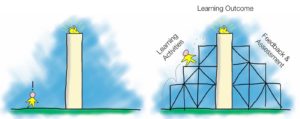 There was a time when what you learned in school before entering the workforce would be all you needed to know for the rest of your career. That is no longer the case. Today, skills can become outdated very quickly.
There was a time when what you learned in school before entering the workforce would be all you needed to know for the rest of your career. That is no longer the case. Today, skills can become outdated very quickly.
The rapid evolution of workplace technologies and best practices means you need to keep your skills current. You can no longer rely only on what you already know and must truly be a life-long learner.
Learning is the process of acquiring new, or modifying existing knowledge, behaviours, skills, values, or preferences. It is a means of honing our skills, enriching our minds, and changing the way we see things in the world.
And because we are all different, everyone learns differently and has to find the way to learn that works best for them. But there’s one interesting concept that will be beneficial to all if applied during learning. It’s called scaffolding.
Scaffolding means breaking up learning into manageable chunks as you progress toward stronger understanding and ultimately greater independence.
Learning using scaffolding resembles a staircase where every new concept has its own stair. You learn a new concept, digest and reflect on it, and integrate it into existing understanding and context before moving on to the next concept (‘stair’).
Learning follows logical patterns of progression with understanding being assessed as you learn – making the journey just as important as the destination.
This contrasts with traditional learning where all concepts, even if complicated, are learned all at once and the understanding tested at the end. This approach does not give concepts their own room to breathe and get digested.
With scaffolding, you learn at your own pace and ability, and grow one step a time. You stop to reflect whenever you want, or return to previously-delivered content, and thus ensure a deeper understanding before continuing. By layering new knowledge onto existing knowledge, you have stronger and broader foundations of understanding.
Hence, for optimum learning outcome, it’s recommended that you use scaffolding, if possible. Here are some ways you can do so:
- Learn one new concept at a time
- Find time to process new concepts and information
- Make connections to what you already know
There are certain cases where the learner is not in full control of the learning process and will not be able to apply the scaffolding technique. In such cases, the ability of the instructor to scaffold the training largely influences the learning outcome, but there’s still a limit on the extent to which individual learners can be met at their pace and ability.
This is the advantage self-paced learning has over traditional classroom delivery with its ‘one-size-fits-all’ approach, whether you are ready or not, whether you assimilate fast or not. The flexibility of pace in self-paced learning gives the learner time to digest and reflect on the information being presented, and time to integrate it into their existing understanding and context.
Learning using scaffolding may, in fact, mean that it takes longer to learn, but the end product is of far greater quality and the experience much more rewarding.